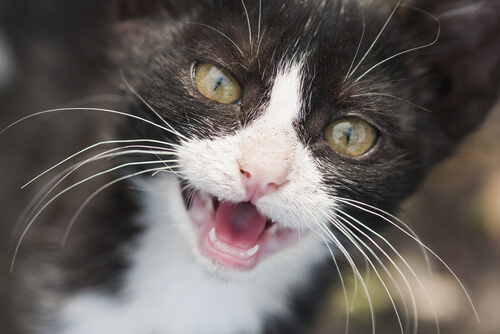Cat Communication: What Is My Cat Trying to Tell Me?

While animals may not be able to use words to communicate, as we can, they are very good at using sounds and body language to let us and other animals know what they’re thinking. Cat communication consists of a mixture of sounds and physical cues, each with its own distinct meaning.
Understanding what your cat is trying to tell you is really important, and can help strengthen the bond between you and your pet. Let’s take a look at the different sounds your cat can make, and what they all mean.
Cat communication: hissing, spitting and other noises

Cats, like most animals, can use both sound and body language to communicate. It’s important to remember that, just like us, our cats have needs and emotions that they need to express to those around them.
Your pet will use a variety of sounds and signals when it wants to tell you something. Understanding what exactly it is your cat is trying to tell you will help improve your relationship, and create a closer bond between you and your pet.
Cat communication: sound
Cats can make a variety of different sounds, including:
Purring
Purring is one of the most common sounds your cat will make. That deep, throaty rumble is usually used to communicate feelings of pleasure and contentment. Some cats have very loud purrs, while others’ are barely audible.
Purring is something cats learn from a very young age. In fact, kittens can purr when they’re just a few days old, making it one of the earliest forms of communication between mother and kitten.
Growling, hissing and spitting
- Growling and grumbling: when a cat growls or grumbles, it is a clear sign that it is extremely unhappy, and may even attack.
- Hissing: this normally occurs when a cat is angry or defensive. It is their way of telling you to leave them alone.
- Spitting: cats will usually spit when they feel threatened. While it sounds a little like a hiss, spitting is stronger and more explosive.
Vocalizing
Needless to say, one of the best-known forms of cat communication is the classic ‘meow’.
Cats normally meow because they want something, such as food or water. This might be a long, drawn-out meow, or a shorter “mew”. However, in some cases, short, repetitive meows can be indicative of pain.
Other forms of cat communication
As we mentioned at the beginning of this article, cats don’t just use sound to communicate. They also have several other methods at their disposal, which we’ll tell you about in this next section.

- Body language: your cat’s body language can tell you a lot about what it is feeling and thinking. For example, pricked ears tell you that your cat is alert, while ears flattened back against the head are a sign of fear or anger. If the hair along its back stands on end, it means that your cat feels scared or threatened.
- Tail: a cat’s tail can tell you many things. A tail held high is a sign of pleasure and confidence, while a lashing tail is a sign of annoyance. Curving the tail beneath the body is a sign of fear or submission.
As you can see, your cat has many ways of communicating with you. Understanding these signs is the key to a great relationship with your feline friend.
Learn what each of these noises and signs means, and try to keep an eye out for them in your cat. With a little time and effort, you’ll soon have no trouble understanding exactly what your pet is trying to tell you.
While animals may not be able to use words to communicate, as we can, they are very good at using sounds and body language to let us and other animals know what they’re thinking. Cat communication consists of a mixture of sounds and physical cues, each with its own distinct meaning.
Understanding what your cat is trying to tell you is really important, and can help strengthen the bond between you and your pet. Let’s take a look at the different sounds your cat can make, and what they all mean.
Cat communication: hissing, spitting and other noises

Cats, like most animals, can use both sound and body language to communicate. It’s important to remember that, just like us, our cats have needs and emotions that they need to express to those around them.
Your pet will use a variety of sounds and signals when it wants to tell you something. Understanding what exactly it is your cat is trying to tell you will help improve your relationship, and create a closer bond between you and your pet.
Cat communication: sound
Cats can make a variety of different sounds, including:
Purring
Purring is one of the most common sounds your cat will make. That deep, throaty rumble is usually used to communicate feelings of pleasure and contentment. Some cats have very loud purrs, while others’ are barely audible.
Purring is something cats learn from a very young age. In fact, kittens can purr when they’re just a few days old, making it one of the earliest forms of communication between mother and kitten.
Growling, hissing and spitting
- Growling and grumbling: when a cat growls or grumbles, it is a clear sign that it is extremely unhappy, and may even attack.
- Hissing: this normally occurs when a cat is angry or defensive. It is their way of telling you to leave them alone.
- Spitting: cats will usually spit when they feel threatened. While it sounds a little like a hiss, spitting is stronger and more explosive.
Vocalizing
Needless to say, one of the best-known forms of cat communication is the classic ‘meow’.
Cats normally meow because they want something, such as food or water. This might be a long, drawn-out meow, or a shorter “mew”. However, in some cases, short, repetitive meows can be indicative of pain.
Other forms of cat communication
As we mentioned at the beginning of this article, cats don’t just use sound to communicate. They also have several other methods at their disposal, which we’ll tell you about in this next section.

- Body language: your cat’s body language can tell you a lot about what it is feeling and thinking. For example, pricked ears tell you that your cat is alert, while ears flattened back against the head are a sign of fear or anger. If the hair along its back stands on end, it means that your cat feels scared or threatened.
- Tail: a cat’s tail can tell you many things. A tail held high is a sign of pleasure and confidence, while a lashing tail is a sign of annoyance. Curving the tail beneath the body is a sign of fear or submission.
As you can see, your cat has many ways of communicating with you. Understanding these signs is the key to a great relationship with your feline friend.
Learn what each of these noises and signs means, and try to keep an eye out for them in your cat. With a little time and effort, you’ll soon have no trouble understanding exactly what your pet is trying to tell you.
This text is provided for informational purposes only and does not replace consultation with a professional. If in doubt, consult your specialist.








